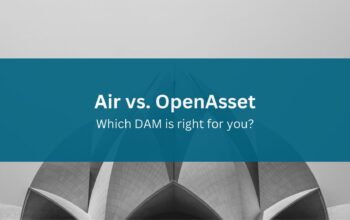The digital landscape is continually expanding and, as such, digital assets have never been more vital to your business. You want to portray your brand and the services you offer in a way that is engaging and easily accessible. On top of this, you need to ensure your team is working efficiently with your digital assets.
Let’s think for a second about the rapidly growing photo libraries within the Architecture, Engineering, and Construction (AEC) and Real Estate industries. Often, images are stored in multiple locations, old images aren’t archived correctly, and large file sizes are a burden on IT teams. It takes a lot of resources to manage the sheer volume of digital assets, especially within industries where images are a crucial business tool. With this in mind, keeping digital assets organized and accessible is fundamental.
What Is Digital Asset Management?
In short, Digital Asset Management (DAM) systems are for storing and organizing your digital assets to make them accessible to those who need them when they need them. Ultimately, making your assets accessible is what gives them value. Digital Asset Management solutions make this possible by creating a centralized, organized repository.
In addition to the essential ability to store and organize your digital files, DAM solutions offer two main functions:
Controlled creation and capture of asset metadata
Every image and file is tagged with relevant information. There are two types of tag, keywords and fields.
Keywords allow you to refine searches for assets using standard search terms.
Fields, on the other hand, give you unique information for each file or project; such as copyright and photographer information. Fields are particularly useful in industries such as AEC and Real Estate that have substantial image libraries.
Digital Asset Management tools to improve workflows
An efficient workflow not only allows you to keep track of your assets, but it ensures the longevity of your digital asset management solution.
Great workflows enable large teams to work together seamlessly, regardless of location. This is facilitated by the way files are shared and routed. For example, DAM systems can push assets to end-users. Enabling your sales team to have the most up-to-date version of assets at their fingertips is one of the many ways digital asset management solutions provide a positive return on investment.
Does Your Company Need DAM?
Year on year, your business will generate more and more digital assets that necessitate management. This is especially relevant concerning image libraries.
Firstly, modern technology makes images easier to produce – we have more devices, and high-quality images are easier to obtain.
Secondly, the demand for images is growing. There are many requirements for high-quality photographs, such as social media marketing, proposals, and presentations.
The other big area of growth is in online video consumption. Consumers now expect to see video content, and businesses are having to rise to the challenge. The AEC and Real Estate industries are producing more high-quality video content to reach their target audiences; this increase in video content significantly impacts the need for efficient storage solutions.
How To Choose A Digital Asset Management Solution
If you’ve established that DAM is the answer to your business’s needs, the question moves onto how best to select a vendor. There is much variety in the market, so it can feel daunting to evaluate the options. Choosing a Digital Asset Management system that’s right for your business means finding the solution best suited to your company needs to achieve.
Here are our six top tips for getting the right fit:
1. Carry out an audit of your digital assets
The first step in choosing a Digital Asset Management solution for your business is to evaluate the size of your asset library and how quickly it is growing.
This can be trickier than it might at first seem, as not everyone in your organization will have the same view. For instance, marketing teams are likely to estimate the volume of digital assets differently to executives. You need to consider how many assets you have, what types of files you need to manage, where they are stored, and who has to access to them. The best way to get a make sense of your digital content is to conduct an audit.
An audit will also help you gain a better understanding of your digital assets. Not only will an audit offer a clear picture of how many digital assets you are holding, but it helps you to identify ways in which you can repurpose content. It also provides an opportunity to ‘spring clean’ your files, pinpointing assets that are no longer of value, and thus should be removed.
2. Assess your business needs
You need to understand how your business is using digital assets, as this will part of your DAM selection criteria. This assessment should include identifying the amount of time staff spend working with and managing images. It may be that without the right digital asset management tools, teams are spending an incredible amount of time editing images.
Talking to the teams that use digital assets is the most accurate way to understand usage. Speak to the marketing and communications team as a starting point, then approach each team that uses digital assets in their regular workload.
For example, project teams and HR can be significant image users within the AEC and real estate industries. You assess everyone’s image management requirements to ensure you find a solution that will work for everyone. You’ll also want to find out what their main concerns are with the way you currently work.
Conducting Research
To get a true reflection of your team’s usage, ask them to track their activities for a week. The research will produce real data for analysis as part of the process of choosing a digital asset management system. Teams should track the time spent on the following activities:
Searching for assets and seeking help from colleagues to locate content
- Looking for copyright information
- Editing images and creating duplicate image sizes and/or resizing images
- Packaging images to send to clients
- Emailing images to collaborate on proposals or other marketing documents
Involving stakeholders at an early stage will help with the implementation of Digital Asset Management requirements further down the line. Communication ensures that everyone understands how DAM will benefit them, and having buy-in from the start will help make a success of the project.
Finally, it is vital to involve your IT department. Although it can be a common perception that IT teams block or slow down new system projects, ultimately their technical knowledge is invaluable. They will be instrumental in ensuring any chosen Digital Asset Management software meets the needs of the business and integrates correctly with existing systems.
3. Consider your technology and functionality requirements
When choosing a Digital Asset Management solution, consider what features you require from the system to meet the business needs identified in your earlier research. This includes options such as project-based tagging, multiple image search options, and user access levels.
The DAM solution you choose should meet as many of your criteria as possible. However, bear in mind that to find one vendor who can meet all of your requirements is unlikely.
Give some thought as to what the most important criteria are for your organization; you can then ask potential vendors to explain how their solution meets these criteria. For example, is the DAM cloud-based and independent of specific hardware?
You will also need to give some thought to your future business needs, how your digital asset requirements will grow, and whether the solution will be future-proof. Cloud-based Digital Asset Management systems are fast becoming the most commonly used due to their ease of integration.
You need to ensure that any solution you select will be able to work with your existing systems, such as a CMS and any project databases. It’s also worth asking potential vendors if you can trial their systems; what better way to ensure that system features are fit for purpose than a direct test of system functionality?
4. Ensure your potential vendors understand your industry
A DAM vendor is ultimately like a business partner; you need to work well together to ensure the system implementation runs as smoothly and with ease. This is more likely to be the case if the vendor understands the industry in which you work. A great way to do this is to look for recommendations.
Ask your vendor to supply references that match your company’s industry and size. You’ll also want to be sure their working practices align with your business objectives and road map. Furthermore, be sure to ask what support they offer after the onboarding process.
5. Account for upfront costs and ongoing value
You will need to understand all of the costs involved when choosing a digital asset management solution. The first most obvious cost is the software itself, but there might also be add-ons and service charges before you can get DAM up and running. These include costs such as software licenses, installation and configuration, data migration, product training, and ongoing support.
You must take these costs into account and balance them against the Return on Investment (ROI). Companies within the AEC and Real Estate industries are often extremely complex, with users in different locations needing simultaneous access to the most current assets available. A system to facilitate this will have great ongoing business value.
6. Set realistic timelines
It can be difficult to set realistic timelines, especially when there is a demand for a new system. It can be tempting to try to rush the process, but it will be much more prudent to take time and ensure correct implementation; you will be using the system for years to come after all.
The best way to set realistic timelines, and manage stakeholder expectations, is to split the process into phases. Your vendor should be able to guide you through the process and create a plan with milestones.
The digital asset landscape has grown immensely in recent decades, and it isn’t slowing down. With a higher demand for high-quality images, efficient storage and sharing capabilities are vital.
Digital Asset Management offers the best solution, not only to manage digital assets but to harness their potential. To help you choose the right Digital Asset Management solution, a review of your content and user requirements is essential. Be sure to collaborate well with teams across your organization, choose a vendor that understands your business needs, and you’ll be reaping the rewards for years to come.



